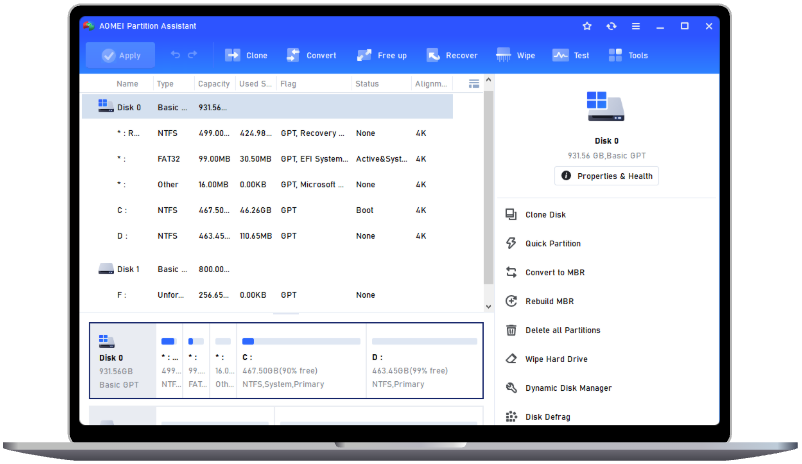[Fixed]: How to Load Windows on a New Hard Drive?
You may need to load Windows on your new drive after replacing a falling or dead old drive. This article provides a step-by-step guide on how to load Windows on a new hard drive.
I just got a new hard drive for my PC and want to replace the old one. How do I load Windows 10 on it? Do I need to change anything in the BIOS?
- Question from User
Replacing drives is a common task for many computer users, especially when upgrading to a faster drive, replacing a failing one, or replacing an HDD with an SSD. However, the process of installing Windows on a new drive can be challenging. Don’t worry! This post will show you how to load Windows on a new hard drive.
How to Load Windows on a New Hard Drive?
This section offers two effective ways to install Windows on a new hard drive. If you are seeking an easier one, go to the Way 2 directly.
Way 1. Perform a Clean Windows Installation
Performing a clean installation is an ideal option when loading Windows on a new drive. This process involves installing Windows from scratch, which means you’ll need to back up your data beforehand and reinstall your applications afterward. While it requires more time and effort, a clean installation is highly recommended for users upgrading to a new drive without an existing Windows setup.
Here’s how to load Windows 10 on a new hard drive using this way:
➤ Stage 1. Create a Windows 10 Installation Media
Before loading Windows 10 on a new drive, you need to create an installation media first.
Step 1. Connect a USB drive to a functional computer. Then, visit the official Microsoft website and download the Windows 10 installation media tool.
Step 2. Launch the tool and select "Create Installation Media (USB flash drive, DVD, or ISO file)".
Step 3. Choose language, architecture, and edition as needed, then click Next to proceed.
Step 4. Select "USB flash drive" and follow on-screen instructions.
Step 5. Choose your USB drive from the list and click Next.
Step 6. Wait for the installation media creation to complete, then safely remove the USB.
➤ Stage 2. Boot from the Created Media
After creating the bootable USB, please insert it into a PC with the new drive. Then, follow the steps below:
Step 1. Restart it and press the BIOS key (F2, Del, F10, or F12) to enter the BIOS setting.
Step 2. Navigate to Boot Manager and set the USB as the primary boot device.
Step 3. Save changes and exit BIOS. Then your PC will boot from the USB.
➤ Stage 3. Load Windows 10 on the New Hard Drive
When the computer reboots, you will enter the Windows Setup interface. Follow these steps to load Windows 10 on the new drive:
Step 1. Select language, architecture, and edition as needed, then click Next to proceed.
Step 2. Click Install now.
Step 3. If you have a product key, enter it. If not, just skip it.
Step 4. In the pop-up window, select "Custom: Install Windows only(advanced)".
Step 5. Select the new hard drive, create a new partition if necessary, then click Next. Then, wait for the installation to complete.
Way 2. Migrate the Operating System
The first method is effective but can be tedious and time-consuming. Is there an easier way to load Windows onto a new drive? Absolutely! AOMEI Partition Assistant allows you to migrate only the operating system from your old drive to a new one (HDD or SSD). This way, you won’t need to reinstall the operating system from scratch, saving you time and avoiding risky operations. If you’re upgrading to a larger drive, you can also use this tool to clone the entire disk, ensuring your PC performs just as it did before.
Here’s how to install Windows on a new drive by migrating the OS:
Step 1. Connect the new drive to your PC and ensure it can be detected. Then, launch AOMEI Partition Assistant and click "Clone" > "Migrate OS".
Step 2. The system-related partitions will be selected as the source by default. Click "Next" to continue.
Step 3. Select the destination location to save the OS and then click "Next".
Step 4. You can preview the source and destination disk and click "Next" to continue.
If you want to resize the partition and modify other information, click "Settings" to adjust and click "Save" to save the changes.
Step 5. Click "Apply" and "Proceed" to commit the migrating process.
Step 6. After migrating the OS, connect the cloned drive internally to your PC. Then enter the BIOS to change the boot drive. Now, you can load Windows on the new drive.
Conclusion
This post explains how to load Windows on a new hard drive. For users looking for an easier method that doesn’t require reinstalling the operating system, Way 2 is highly recommended. Whether you decide to perform a clean installation or use AOMEI Partition Assistant to clone your existing OS, make sure to back up your important data before starting the process.
FAQs
Q1: How long does it take to load Windows on a new hard drive?
A clean installation typically takes 30 minutes to 2 hours, depending on hardware performance and installation steps. If cloning an existing drive, the duration varies based on data size and drive speed.
Q2: Will I lose my Windows license if I install Windows on a new drive?
No. Windows 10/11 licenses are tied to your motherboard or Microsoft account. After installation, it should auto-activate once connected to the internet.
Q3: Can I reuse my old hard drive after transferring Windows to the new one?
Absolutely! You can format the old drive and repurpose it as secondary storage, a backup drive, or an external drive.


